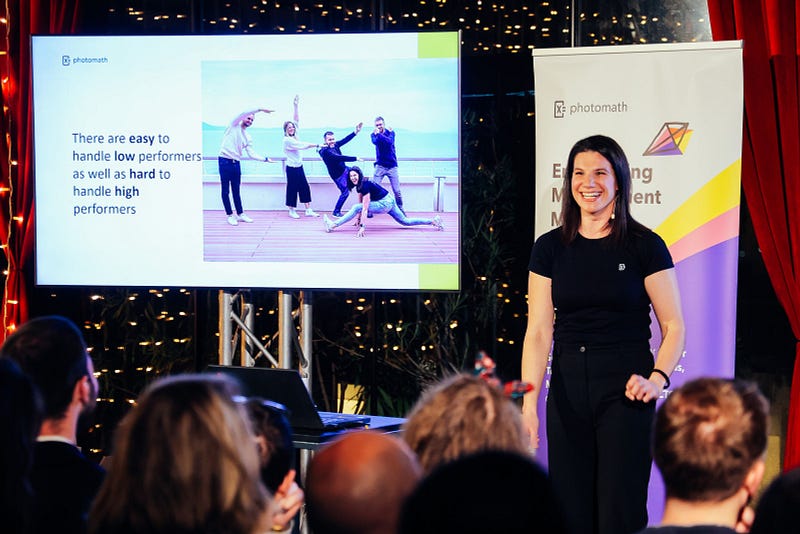Meet The Team: Nicolette Pribanić, Engineering Manager at Photomath

In celebration of International Women’s Day, we’re pleased to introduce the first instalment of a new blog series that will spotlight women on our team working in technical roles, and the unique, exciting work they do every day to help advance our mission.
Today, women still make up just 28% of the workforce in STEM fields. Photomath is home to a vibrant community of women in tech, and we’re proud that over 50% of our team are women including 55% of our leadership team. We’ve seen firsthand how powerful it can be when women are given the opportunity to lead. We’re committed to doing our part to enable and empower more women in tech, and by making learning math more accessible for people all over the world.
Our first instalment in this series features Photomath’s Engineering Manager Nicolette Pribanić who joined our team in December 2021. Read on to learn more about Nicolette’s career path in engineering and her advice to support the next generation of women in tech, and look out for more stories featuring the Photomath team.
Tell us about yourself and your role at Photomath.
I studied at the Faculty of Electrical Engineering and Computing in Zagreb, where I obtained the academic title of Master of Science in Computing. I started my career as a software engineer, and at the same time, tried my hand at various management roles. During my 8-year career (of which about five years in coordination and team management), I always tried to develop my communication and leadership skills in addition to my technical skills. Currently, I work as an engineering manager at Photomath, where I lead the Core team responsible for some of the fundamental elements of the Photomath application.
The decision for me to join Photomath as an engineering manager felt like the right next step in my career, though I have a good friend to thank for encouraging me to apply. He believed it was a great opportunity in a company that would fulfil my ambitions. After some persuasion on his part, and me thinking about the next chapter of my career, I decided to go for it. During the interview, I met employees who had been at Photomath for years, as well as some newer engineering leads and had great conversations about the interesting, challenging work the team gets to support. I was convinced of how strong, smart, and ambitious the team is, and knew I wanted to be part of it.
How / when did you become interested in pursuing tech and engineering?
When I was in high school, we had to choose a priority list of faculties that we wanted to apply to, and I couldn’t decide what I really wanted to do in life. On one hand, I had dreams of becoming a veterinarian because I grew up with animals. On the other hand, since I was good at math, I thought about enrolling in the Faculty of Science mathematics programme. Then a friend suggested that I enrol in a popular and demanding faculty that involves a lot of mathematics and logical thinking, but also helps ensure a promising career in tech. That’s how I ended up at the Faculty of Electrical Engineering and Computing, where I fell in love with technology and programming.
What excites you about the work you and your team are doing at Photomath?
I’m excited about several aspects of the work that my team and I are doing at Photomath. Firstly, our impact on students’ lives is motivating. Our Solver product generates step-by-step solutions to math problems, and it’s rewarding to know that our efforts are contributing to making a positive difference in education.
Secondly, I find it thrilling to be part of a smart, ambitious engineering team that is always learning and growing. We stay up-to-date with the latest technologies and collaborate with other teams that are at the forefront of using AI to revolutionise education. Seeing the impact our work is having on learners worldwide is incredible, and collaborating with passionate and driven individuals dedicated to making a difference is inspiring.
Moreover, I appreciate the openness and inclusivity that characterizes Photomath’s culture, fostering a supportive and engaging work environment. We prioritize work-life balance and professional development, enabling us to grow both personally and professionally.
Why do you think there are much fewer women in engineering? And what steps or resources can be initiated to empower & support attracting more women into the field?
I think the biggest problem is society’s stereotypes and cultural expectations. There is a prevailing notion that engineering is a male-dominated field, which can discourage women from pursuing careers in this area. It starts early on, where even today, toys for girls are children’s kitchens or Barbies, while toys for boys are robots or mechanical sets. Fortunately, I had a supportive environment at home, and my parents tried to protect me from prejudices or imposed career rules.
Another reason I think there are fewer women in engineering, and one that I have experienced in past roles on several occasions, is that women may face challenges in the workplace, such as gender-based discrimination, harassment, and a lack of support and opportunities for career advancement. This can make it difficult for women to thrive in the competitive and often demanding engineering industry. I believe that there are several steps and resources that can be taken to empower and attract more women into the field of engineering.
Firstly, we should encourage girls from an early age to explore their interests in STEM fields, particularly in engineering, by exposing them to relevant activities, programs, and experiences. This could include introducing them to basic engineering concepts, taking them on site visits, or inviting women engineers to speak to them about their experiences.
Secondly, we should create inclusive learning environments where girls and women feel welcomed, supported, and encouraged to participate in engineering fields. This could involve providing mentors, role models, and support groups, as well as ensuring that curriculum, teaching, and assessment practices are gender-neutral and bias-free.
Lastly, we should celebrate and promote the contributions of women in engineering to increase visibility, awareness, and representation of women in the field. This could be done through recognition programs, awards, and public events that showcase the achievements of women in engineering.
Women make up more than half of our Photomath’s team and 55% of our leadership team are women, so it’s inspiring to work alongside so many talented women. I’m proud to be part of an organization that actively recognizes the contributions of everyone on our team and creates meaningful opportunities for people to feel excited and challenged by the work we’re doing everyday to make learning more accessible.
Do you have any advice for young women who are just starting their careers in tech & engineering?
Don’t be afraid to express your own opinion, ask questions, and advocate for your needs and interests. It’s important to be assertive and confident in your abilities and to communicate your value to others.
Surround yourself with a network of mentors, peers, and allies who can provide guidance, support, and encouragement as you navigate your career in tech and engineering. The tech industry can be competitive and challenging, and you may face setbacks and failures along the way. It’s important to be resilient and persistent in the face of obstacles and to view setbacks as opportunities to learn and grow.
And most importantly, learn to say “no.” Learning to say “no” is an important skill that can help you manage your time, set boundaries, and prioritize your goals. In the fast-paced world of tech and engineering, it can be easy to take on too much work and spread yourself too thin. Saying “no” can be difficult, especially when you want to please others or feel pressure to be always available, but it is essential for maintaining your well-being and preventing burnout.
What is most gratifying about your work at Photomath?
The most gratifying aspect of my work at Photomath is the impact we’re making on students’ lives. Knowing that we are helping learners understand and appreciate mathematics is fulfilling. Our mission to make learning accessible through artificial intelligence and empathy is at the core of everything we do, and it’s incredible to see the results of our efforts firsthand. Seeing students gain confidence in their understanding and excel in their studies is the ultimate reward.
How do you envision the future of learning and how do you think Photomath will be part of that?
The future of learning is rapidly evolving, and we are witnessing a shift towards more personalized, accessible, and engaging learning experiences. Technology will play a crucial role in this transformation, and artificial intelligence will be at the forefront of creating these experiences. As we move towards a more digital world, the potential to democratize education and make it more accessible to people worldwide is immense.
One way in which we see Photomath being a part of the future of learning is through the use of our AI-powered math solver. Our app has helped millions of learners worldwide understand and appreciate mathematics by providing step-by-step solutions to math problems. We believe that this technology can be used to support personalized learning and to provide learners with real-time feedback and support.
We see Photomath playing a key role in creating a more inclusive and diverse learning environment. Our mission to make learning accessible through artificial intelligence and empathy means that we are constantly looking for ways to create a more personalized and engaging experience for all learners, regardless of their background or learning style.

